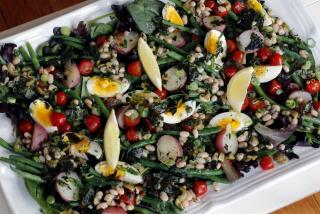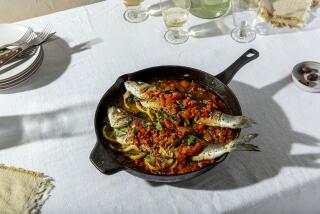Going Green : Nutrition: Two new studies confirm that the closer we stick to a plant-based diet, the healthier we will be.
- Share via
A vegetarian diet is getting good press lately.
In recent months, two impressive studies showed that eating greens and grains will help ward off the chronic diseases that plague Western nations--heart disease, cancer, osteoporosis and obesity.
The closer we get to a vegetarian diet, eating a wide variety of plant foods with a minimum of animal foods, the better off we might be, says T. Colin Campbell, the principal American investigator of the massive ongoing study released last spring, “Diet, Life-Style and Mortality in China.” A 920-page book of the study is to be published shortly by Cornell University Press.
Not only has such a diet been shown to reduce disease risks, but “the evidence shows that we can get all the nutrients we need on a low-fat plant-based diet,” said Banoo Parpia, a research associate for the China study.
More support for the low-fat vegetarian diet comes from Dr. Dean Ornish, an assistant clinical professor of medicine at the University of California (San Francisco) School of Medicine and president and director of the Preventive Medicine Research Institute in Sausalito, Calif. He has found that, among 41 patients with severe heart disease, a low-fat vegetarian diet, stress reduction and exercise can unplug arteries and reverse heart disease, America’s No. 1 killer, according to a research paper published this summer in the Lancet, a British medical journal.
By reducing fat to no more than 10% of daily calories, and cholesterol intake to five milligrams, 82% of his patients experienced reversal in artery blockage. Ornish has detailed the study and tells how you can make similar changes in “Dr. Dean Ornish’s Program for Reversing Heart Disease” (Random House; $24.95).
For many people who have heart disease, conventional recommendations for changing diet and lifestyle may not go far enough, Ornish said. Current advice for fat intake is 30% of calories or less, and less than 300 milligrams of cholesterol, but Ornish said in a telephone interview that in his control group, “artery disease increased at the 30% intake.”
“Only a diet almost entirely free of animal fat, oil and cholesterol will significantly lower blood cholesterol levels reliably in just about everyone,” Ornish says.
Although Ornish does not minimize the difficulty of making dramatic changes, he said, “once you get started, a diet vibrant with color and rich with flavors and textures of fresh vegetables, beans and pasta, grains and fruit-based desserts could be pleasurable.”
Other experts want more evidence to support Ornish’s diet or the Chinese approach. “Right now, a 30% fat limit is a sensible approach for reducing the intake of saturated--or animal--fat, which is the number one villain for elevating cholesterol,” said Nancy Ernst, head nutritionist with the National Cholesterol Education Program. “The China diet hasn’t been followed here. We don’t know if, genetically, the Asians are less susceptible to osteoporosis and the other chronic diseases we get here. We need more of an assessment of their diet, or even the Ornish diet, before we can recommend it.”
Jane Newmark, a spokeswoman for the American Dietetic Assn., also is cautious. The changes may sound good, but “you need to know what you are doing, you need to know where to get your calcium, your protein, your iron. It’s a big lifestyle change,” Newmark said.
However, William P. Castelli, medical director of the Framingham Heart Study, is firmly behind this low-fat, low-cholesterol approach. He believes the villain is diet and lifestyle. “If you flew four billion of the world’s plant-eating people over to this country and put them on our bloody American diet, they would wind up with the same blooming (heart-disease) epidemic Americans have,” Castelli said.
The 6,500 Chinese in 65 primarily rural Chinese counties studied from 1983 to last year were primarily vegetarians who ate small amounts of meat, virtually no dairy products and less fat than Americans. The results of the study, partly financed by the National Institutes of Cancer, are fascinating and suggestive. Among the findings:
Weight Control
Rural Chinese eat 20% more calories than we do and are 20% thinner. Their exercise level too is far higher. “People bicycle everywhere; poorer peasants travel on foot,” Parpia said.
In rural China, peasants eat less than 15% of their calories as fat and 77% of their total calories come from complex carbohydrates--rice, grains, vegetables. The Ornish diet limits fat to 10%. In China, animal-protein intake is a third less than ours. But, as “the Chinese become more affluent and consume more animal protein and fat, their risk for heart disease and cancer increases,” Parpia said.
In the Ornish diet, the only animal protein allowed is nonfat milk, nonfat yogurt and egg whites.
Osteoporosis
While the Chinese eat few dairy products and consume only half as much calcium as people in the United States, they have far less osteoporosis, a bone-thinning disease that affects one out of every four post-menopausal U.S. women. Although the women in the China study filled their calcium needs with vegetables, a leading American expert cautions that may not be applicable here.
“It is very hard to get good epidemiological research on osteoporosis from Chinese peasants whose life expectancy is much less than in Western countries,” said Dr. Lawrence B. Riggs, president of the National Osteoporosis Foundation and a professor of Medical Research at the Mayo Clinic Foundation in Rochester, Minn.
“They don’t live long enough to get the fractures. You have to add in the exercise factor, and very few elderly in this country exercise the way the Chinese peasants do. We really don’t know yet how much calcium is absorbed from tofu and leafy green vegetables,” said Riggs, who still thinks it is prudent for Western women to follow the RDA calcium intake for 800 milligrams a day. Low-fat dairy products--nonfat yogurt and skim milk--have the same, if not more calcium than their high-fat counterparts, he said.
Cancer
The average Chinese adult, whose fiber intake is three times greater, according to the study, is two to three times less likely to develop colon cancer than an American. And even at very high intakes of 77 grams a day in some regions (Americans are advised to consume 20 to 30 grams a day, but most get much less), there is no evidence that the Chinese suffer from the impaired mineral absorption that American scientists warn us too much dietary fiber can cause.
Fat plays a role too. In another cancer study that looked at Chinese here and in China, “high intakes of saturated fat and low levels of physical activity increased colo-rectal cancer risks three- to five-fold,” said Alice S. Whittemore, a Stanford University professor who was primary investigator of the study sponsored by cancer institutes of three countries--the United States, Canada and China.
In both Whittemore’s study and in the China diet, researchers found that a high vegetable intake is protective. Eating more broccoli and leafy greens or vegetables rich in antioxidant nutrients plays a role in inhibiting the growth of some cancerous tumors, said Parpia.
Heart Disease
In China, where the people eat few animal products, cholesterol levels are low and heart disease is rare. The average cholesterol level in China is 127. While Americans are encouraged to lower their cholesterol levels to 200 or less, the Ornish plan recommends a cholesterol level of 150. On average, American cholesterol levels are 212, a risk factor for the more than 1.5 million Americans who suffer heart attacks each year.





